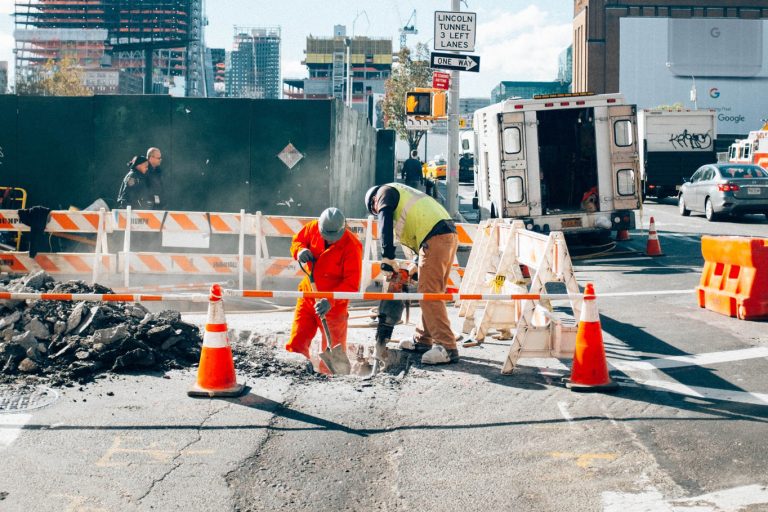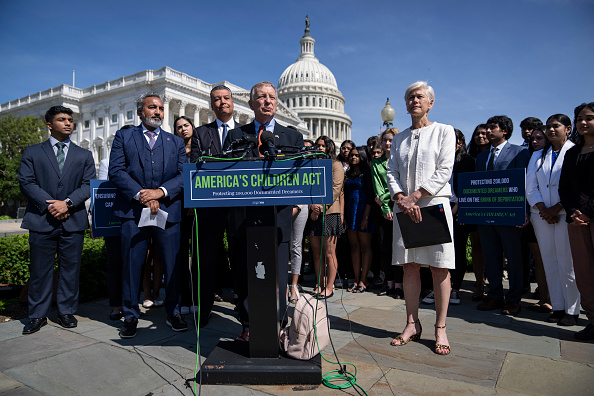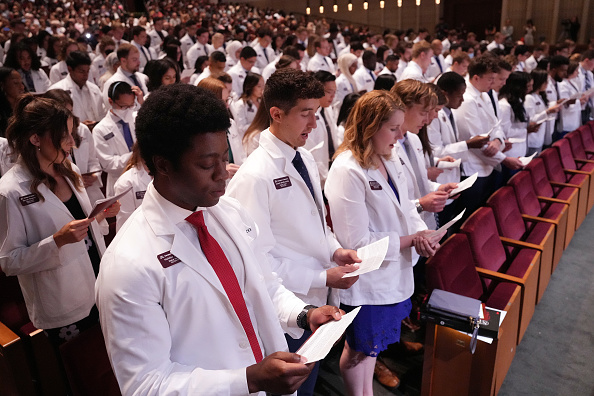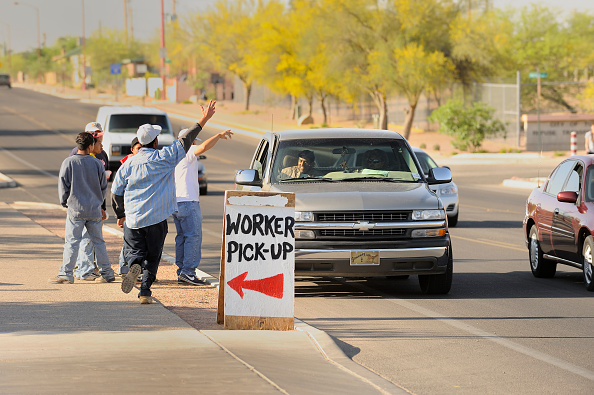
It’s been 36 years since Congress passed comprehensive immigration reform. The last two times it came close to doing so, in 2007 and again in 2013, one fundamental point remained at the center of negotiations: a mandatory federal program known as E-Verify for checking the immigration status of workers.
“E-Verify, E-Verify — that’s what it always came back to,” a former Democratic congressional staffer told Ideaspace when recalling the 2007 legislative negotiations. “We knew we weren’t going to get anything done if that wasn’t included.”
 The idea that a federally mandated E-Verify system is central to immigration reform still thrives. Republican congressional leaders included it in their “Commitment to America” plan, released in September, and while some Democrats push back on the idea, many prominent Democratic leaders, such as Pete Buttigieg and Amy Klobuchar, have embraced it at various points.
The idea that a federally mandated E-Verify system is central to immigration reform still thrives. Republican congressional leaders included it in their “Commitment to America” plan, released in September, and while some Democrats push back on the idea, many prominent Democratic leaders, such as Pete Buttigieg and Amy Klobuchar, have embraced it at various points.
For more than two decades, a voluntary version of E-Verify has been in place. So what are E-Verify’s objectives, and is the program achieving those objectives in empirical terms? Ideaspace talked to academics who have studied E-Verity, as well as former government employees from the Justice Department and the Department of Homeland Security, in order to understand the challenges of executing the program and to understand why it hasn’t accomplished what it was designed to do: reduce illegal immigration.
***
It all began with IRCA — the Immigration Reform and Control Act of 1986, a piece of legislation that was more than a decade in the making.
Pres. Ronald Reagan and the Republicans were willing to go along with granting legal status to an estimated 3 million undocumented immigrants, but only if mechanisms were put in place to cut off the flow of more unauthorized entries. The idea was to legalize the undocumented immigrants who were already in the U.S. and shut the door behind them.
 Beyond increased funding for border security, IRCA’s main provision for controlling future immigration was to prohibit employers from knowingly hiring undocumented immigrants. The idea was that many — if not most — undocumented immigrants come to the U.S. for work. If employers were sanctioned for hiring people who don’t have authorization to be in the country then the number of undocumented immigrants would decrease. IRCA required employers to collect approved identification documents for new hires and complete paperwork for the federal government confirming that the submitted documents establish an employee’s authorization to work in the country. Employers who knowingly hire unauthorized workers are subjected to escalating civil fines and the possibility of debarment from government contracts. This is where the I-9 form was born. The Employment Eligibility Verification form is legally required for every new hire in the U.S. and must be completed by the third day of employment.
Beyond increased funding for border security, IRCA’s main provision for controlling future immigration was to prohibit employers from knowingly hiring undocumented immigrants. The idea was that many — if not most — undocumented immigrants come to the U.S. for work. If employers were sanctioned for hiring people who don’t have authorization to be in the country then the number of undocumented immigrants would decrease. IRCA required employers to collect approved identification documents for new hires and complete paperwork for the federal government confirming that the submitted documents establish an employee’s authorization to work in the country. Employers who knowingly hire unauthorized workers are subjected to escalating civil fines and the possibility of debarment from government contracts. This is where the I-9 form was born. The Employment Eligibility Verification form is legally required for every new hire in the U.S. and must be completed by the third day of employment.
But questions soon arose about the possibility of fraudulent documents. Were employers now responsible for testing the veracity of a driver’s license or social security card? If so, how? To leaders of both parties, it seemed an inappropriate role to assign to an employer.
So when Congress passed the Illegal Immigration Reform and Immigrant Responsibilty Act of 1996, a bill with a more narrow scope than IRCA, it included a provision for three pilot programs that would allow employers to check the veracity of a worker’s documents against available federal databases. One of those programs is still around today and has become known as E-Verify. Initially it was exclusive to California, Florida, Illinois, Nebraska, New York, and Texas, which had at that time the five biggest immigrant populations in the U.S., and it was only intended for certain industries — chiefly, agriculture, food services, meat-packing, and construction.
 The program was supposed to expire after four years but Congress reauthorized it in 2001 and again in 2003 when it was opened up to employers in all 50 states. In 2005, the program became entirely internet based and employer use of E-Verify has steadily climbed since then. In 2001, there were 18 participating employers; today there are nearly 1 million. The government estimates that 13 percent of all private employers in the U.S. use E-Verify. All of this notwithstanding the fact that E-Verify remains, in official terms, a pilot program.
The program was supposed to expire after four years but Congress reauthorized it in 2001 and again in 2003 when it was opened up to employers in all 50 states. In 2005, the program became entirely internet based and employer use of E-Verify has steadily climbed since then. In 2001, there were 18 participating employers; today there are nearly 1 million. The government estimates that 13 percent of all private employers in the U.S. use E-Verify. All of this notwithstanding the fact that E-Verify remains, in official terms, a pilot program.
Originally E-Verify was entirely voluntary, but in 2008 President Bush signed an executive order requiring federal contractors and subcontractors to use the program and it was around that time that states began passing legislation that mandated use of the program for all or most employers. The 2008 Legal Arizona Workers Act not only mandated E-Verify for all employers in the state, public and private, but put in place the possible suspension or revocation of a business license if an employer failed to use the program. The Arizona state law faced legal challenges including the U.S. Chamber of Commerce v. Whiting, a case heard in 2010 by the U.S. Supreme Court, which determined that the law was not preempted by federal legislation.
After the Whiting decision upheld the Arizona law, other states began taking action. Mississippi, South Carolina, and Alabama have joined Arizona in requiring all employers, both public and private, to use E-Verify, while 18 additional states have an E-Verify mandate with exceptions of some kind.
It is in this context — high programmatic ambitions now set in a fractured landscape — that we must evaluate the E-Verify system.
***
According to Geoffrey Heeren, Associate Professor of Law and the Director of the Immigration Litigation and Appellate Clinic at the University of Idaho, one of the biggest flaws in E-Verify was actually written into IRCA.
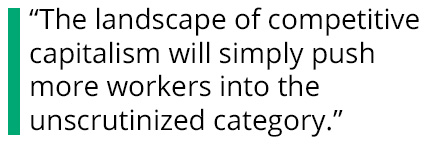 “It’s not required for an employer to check employment authorization for an independent contractor,” says Heeren. “So that opens up a significant sector of the economy. That’s a major group of employers that don’t even have to check employment authorization.”
“It’s not required for an employer to check employment authorization for an independent contractor,” says Heeren. “So that opens up a significant sector of the economy. That’s a major group of employers that don’t even have to check employment authorization.”
According to most estimates, 13 percent of the U.S. economy relates to jobs that are performed by independent contractors. It’s a number that has been growing for decades with the rise of the “gig economy.” Use of the independent contractor model has, for instance, completely transformed the taxi industry with operating models established by companies like Lyft and Uber. The prominence of independent contractors and similar categories of workers in the overall economy is hard to measure and, according to Heeren, is likely bigger than the 13 percent figure.
Kate Griffith, a Professor at Cornell University’s School of Industrial and Labor Relations, says that after IRCA was established, employers simply changed their hiring practices. “Independent contracting blew up after ’86 because it was a way around IRCA,” says Griffith. “They’re not employees, they’re independent contractors. ‘I’m telling them what to do, but they’re not employees.’ So you just sidestep the verification entirely.”
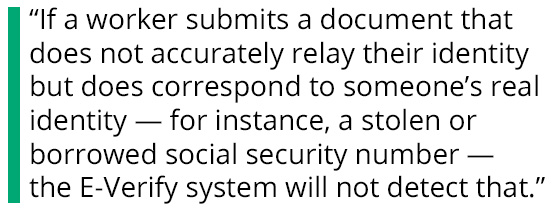 While IRCA isn’t single-handedly responsible for the rise of the independent contractor model, it certainly served as an accelerant as employers began making this shift. Not only could employers avoid checking a worker’s immigration status but they could also realize savings by avoiding health insurance and other benefits expected by an employee but not by an independent contractor.
While IRCA isn’t single-handedly responsible for the rise of the independent contractor model, it certainly served as an accelerant as employers began making this shift. Not only could employers avoid checking a worker’s immigration status but they could also realize savings by avoiding health insurance and other benefits expected by an employee but not by an independent contractor.
On more than one occasion the U.S. Supreme Court has determined that there are not one-size-fits-all rules regarding whether a worker is an independent contractor or an employee. More than once, the Court has upheld that the totality of a worker’s situation and activity should dictate the status — most notably in the 1947 decision, United States v Silk. The essential elements established by the Court are: the permanency of the relationship, the amount an independent contractor invests in the equipment and facilities they use, the independent contractor’s opportunities for profit and loss, the amount of control the employer has over the independent contractor’s schedule, and the extent to which the services rendered are an integral part of the employer’s business.
Griffith and other experts highlight that there is little enforcement for any misuse of the “independent contractor” classification. “Unlike Western European countries,” says Griffith, “where they have a lot of inspectors and there’s government audits and governments taking a very active role in making sure people are being paid on time and getting classified correctly, our system is much more hands off. We don’t have that many inspectors. What we rely on is workers to come forward and say, ‘Hey, I didn’t get paid overtime, or wasn’t paid for all my hours, or I think I should be classified as an employee.’”
 In the 2019 paper, “Trump’s ‘Immployment’ Law Agenda: Intensifying Employment Based Enforcement and Un-authorizing the Authorized,” Griffith documented that in 2006 — and again in 2007 — the Bush administration conducted fewer than 1,000 employer audits that would examine, among other things, worker classification. The Obama and Trump administrations stepped up audits but still topped out at roughly 3,000 and 6,000 annually, respectively — in the context of tens of millions of businesses throughout the country, and 31 million small businesses alone. And when the Trump administration reached the 6,000 case peak it created a backlog for Homeland Security Investigations (HSI), the division within the Department of Homeland Security responsible for carrying out enforcement when it comes to employer sanctions for hiring unauthorized workers.
In the 2019 paper, “Trump’s ‘Immployment’ Law Agenda: Intensifying Employment Based Enforcement and Un-authorizing the Authorized,” Griffith documented that in 2006 — and again in 2007 — the Bush administration conducted fewer than 1,000 employer audits that would examine, among other things, worker classification. The Obama and Trump administrations stepped up audits but still topped out at roughly 3,000 and 6,000 annually, respectively — in the context of tens of millions of businesses throughout the country, and 31 million small businesses alone. And when the Trump administration reached the 6,000 case peak it created a backlog for Homeland Security Investigations (HSI), the division within the Department of Homeland Security responsible for carrying out enforcement when it comes to employer sanctions for hiring unauthorized workers.
In a system without robust enforcement that allows one type of worker status to be scrutinized for labor law compliance while allowing another type of worker status to go unquestioned, the landscape of competitive capitalism will simply push more workers into the unscrutinized category.
***
The fundamental challenge of E-Verify is how easy it is to avoid — even when mandated. Whether it’s misclassifying workers, accepting false documents, or keeping new employees off the books — opportunities for avoiding verification abound. “You have all the issues that probably most people know,” says Heeren, “which is that there are a lot of jobs that are under the table and where employers should be checking, but they don’t. Then there are other jobs where employers are checking, but they’re doing it in a way that is sometimes blissfully ignorant, willfully ignorant in many cases, of the use of false documents.”
If a worker submits a document that does not accurately relay their identity but does correspond to someone’s real identity — for instance, a stolen or borrowed social security number — the E-Verify system will not detect that.
So how often does E-Verify err when determining someone’s eligibility to work in the U.S.? There are a few different ways to frame the idea of an “error rate.”
 Much of the research on E-Verify error rates was conducted more than a decade ago, when a flurry of states rushed to implement E-Verify requirements in the wake of the Whiting decision. A 2010 report from the Westat Corporation took a look at two different types of errors that sometimes occur within E-Verify. The report showed that less than 1 percent of workers who were ultimately deemed to be authorized for employment by E-Verify were initially identified incorrectly as unauthorized, but a whopping 54 percent of workers who were ultimately determined by E-Verify to be unauthorized were incorrectly identified initially as authorized. The overall error rate provided in the report was 4.1 percent — a weighted outcome because most of the examined cases fell into the first of the two categories. In the E-Verify world, if you’re permitted to work in our country, then you rarely run into a system error but, as noted above, if a worker who is not permitted to work in our country submits false documents, the chance of a system error that lets the applicant slip through goes up dramatically.
Much of the research on E-Verify error rates was conducted more than a decade ago, when a flurry of states rushed to implement E-Verify requirements in the wake of the Whiting decision. A 2010 report from the Westat Corporation took a look at two different types of errors that sometimes occur within E-Verify. The report showed that less than 1 percent of workers who were ultimately deemed to be authorized for employment by E-Verify were initially identified incorrectly as unauthorized, but a whopping 54 percent of workers who were ultimately determined by E-Verify to be unauthorized were incorrectly identified initially as authorized. The overall error rate provided in the report was 4.1 percent — a weighted outcome because most of the examined cases fell into the first of the two categories. In the E-Verify world, if you’re permitted to work in our country, then you rarely run into a system error but, as noted above, if a worker who is not permitted to work in our country submits false documents, the chance of a system error that lets the applicant slip through goes up dramatically.
In recent years there has been less third-party scrutiny but the perpetually-renewed pilot program continues to grow. Thirty-seven million cases were run through E-Verify in 2020 and, according to USCIS’s self-reporting, E-Verify’s “success rate” that year was 99.6 percent. In light of the 2010 Westat report, it seems USCIS may not be doing a thorough analysis to get a sense of how many fraudulent documents are getting past E-Verify.
In order to cut down on the error rate for unauthorized workers being initially identified as authorized — often driven by undetected fraudulent documents — some have argued for updating E-Verify to include the use of biometric data such as fingerprints or retinal scans, which could in theory provide a “second verification” that might reveal any discrepancy between the individual and the identifying papers being submitted. Such biometric data could be linked to a digitized ID card with radio-frequency identification technology, not unlike the chips embedded in today’s credit cards.
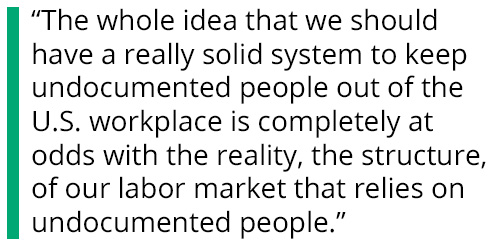 Juliet Stumpf, a professor at Lewis & Clark Law School who has conducted extensive research about E-Verify and employer sanctions, points out that inclusion of any such technology would require willing participation from every worker in the country. “Conceivably, we could introduce biometrics into the work authorization program,” she says, “and we could use, for example, a fingerprint scheme or retina scans and it’s quite possible that we would have some increased accuracy in our work authorization checking. But what it would require is fingerprinting everybody in the United States or retina scanning everybody in the United States. I suspect we may have a real discomfort from the public with being required to undergo biometrics identification in order to work.”
Juliet Stumpf, a professor at Lewis & Clark Law School who has conducted extensive research about E-Verify and employer sanctions, points out that inclusion of any such technology would require willing participation from every worker in the country. “Conceivably, we could introduce biometrics into the work authorization program,” she says, “and we could use, for example, a fingerprint scheme or retina scans and it’s quite possible that we would have some increased accuracy in our work authorization checking. But what it would require is fingerprinting everybody in the United States or retina scanning everybody in the United States. I suspect we may have a real discomfort from the public with being required to undergo biometrics identification in order to work.”
Stumpf’s suspicion is supported by the public resistance to sweeping public health mandates during the COVID-19 pandemic. As attractive as newer technologies might be for improving E-Verify in theory, the practical considerations make these possibilities hard to imagine. In light of long-standing privacy concerns expressed across the political spectrum, it seems implausible that the needs of E-Verify would lead every worker in America to accept biometric identification.
“I think that E-Verify is not a program that can be fixed through some technological tweaks,” says Heeren, echoing Stumpf’s reservations about biometrics. “Just having a better platform or something along those lines is not going to fix E-Verify because the problems with E-Verify are built in at the level of the actual law itself and the broader economic and political factors.”
All of these mitigating factors — misclassifying workers, the use of false documents, keeping workers off the books — prevent E-Verify from achieving its stated goal: the reduction of illegal immigration. “If what we’re trying to accomplish is reducing the level of undocumented immigration, that hasn’t born out, historically,” says Stumpf. “We are seeing higher levels of undocumented immigration than we were seeing before IRCA was passed by Congress in 1986.”
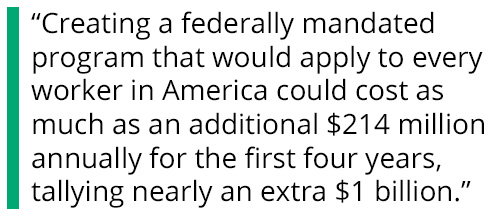 Stumpf and other legal experts underscore that the issue isn’t the inefficacy of E-Verify, per se, but the more fundamental issue of whether or not employer sanctions can serve as the linchpin of a system for reducing undocumented immigration. “I think the whole idea that we should have a really solid system to keep undocumented people out of the U.S. workplace is completely at odds with the reality, the structure, of our labor market that relies on undocumented people,” says Jennifer Gordon, a professor of law at Fordham University who studies the intersection between immigration and labor. “That’s the broad background truth against which employer sanctions are set.”
Stumpf and other legal experts underscore that the issue isn’t the inefficacy of E-Verify, per se, but the more fundamental issue of whether or not employer sanctions can serve as the linchpin of a system for reducing undocumented immigration. “I think the whole idea that we should have a really solid system to keep undocumented people out of the U.S. workplace is completely at odds with the reality, the structure, of our labor market that relies on undocumented people,” says Jennifer Gordon, a professor of law at Fordham University who studies the intersection between immigration and labor. “That’s the broad background truth against which employer sanctions are set.”
Not only does E-Verify lack a track record for reducing illegal immigration or identifying fraudulent documents but it comes at a significant cost. USCIS, the federal agency that administers E-Verify, is a rare breed: a self-funding federal agency. It mostly pays for the work it does by collecting dues and fees from migrants making their way through the immigration system. E-Verify is one of the few programs that costs the agency money — to the tune of $118 million in 2021 alone. What’s more, a 2016 report from DHS and the Congressional Budget Office estimated that creating a federally mandated program that would apply to every worker in America could cost as much as an additional $214 million annually for the first four years, tallying nearly an extra $1 billion.
Saving taxpayers from this expense would undoubtedly have political upside for both parties but Republicans have additional incentive to walk away from E-Verify because it is a glaring example of the federal government inserting itself into the dynamics of the labor market —– something the party traditionally is inclined to oppose.
***
 Beyond the failure to reduce illegal immigration, there are also concerns about how the E-Verify program can be leveraged by employers in ways that hurt workers. “I believe that E-Verify incentivizes the use of false documents,” says Hereen, “which has really negative ramifications for the workers themselves. It keeps people in undocumented status because the fact that they used false documents in the past creates a barrier to them ever fixing their status.”
Beyond the failure to reduce illegal immigration, there are also concerns about how the E-Verify program can be leveraged by employers in ways that hurt workers. “I believe that E-Verify incentivizes the use of false documents,” says Hereen, “which has really negative ramifications for the workers themselves. It keeps people in undocumented status because the fact that they used false documents in the past creates a barrier to them ever fixing their status.”
Hereen points out that false documents not only have negative consequences for the workers who submit them but also for the economy as a whole. “It creates a race to the bottom,” he says “where all sorts of behavior that is not really on the up and up is being incentivized.”
Accessing the E-Verify system is easy. With no oversight, all that’s required is an employer identification number and contact information including a physical address. Use of the system can be gained in little over an hour after perusing just a few tutorials and taking a brief, self-administered exam. Rules and guidelines for how E-Verify must be used to avoid discrimination are clearly laid out in the tutorial modules but, again, there is little enforcement of these guidelines. Once access to the system is gained, it can be used for any purpose if the user is willing to break the rules.
Several lawyers who have worked for the U.S. government and spoke to Ideaspace on the condition of anonymity reported encountering various allegations of abuse of the E-Verify system. “There were allegations that landlords were using it,” said one former Justice Department lawyer. “There were allegations that election officials were using it to try to do identity verification and citizenship status verification for voters, and this was all without people’s knowledge or consent. Once you have a database screening system out there, the Department of Homeland Security is nearly powerless to stop anyone from using it in any way that they want.”
USCIS does have a Monitoring and Compliance Branch for E-Verify and it operates the Data Analysis System (DAS), which employs algorithms and statistical techniques to identify complex patterns of employer behaviors, such as discrimination and fraud. But DAS can only detect the most egregious cases of employer misbehavior. For example, DAS can’t detect whether an employer knowingly accepts a false social security number, but it might be able to detect if an employer allows several different employees to use the same social security number. Even so, USCIS has scant resources for following through on the limited leads DAS produces.
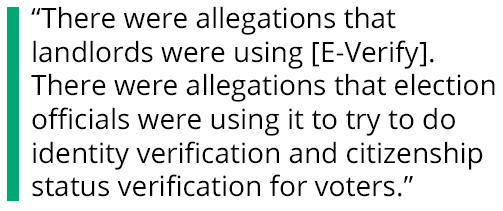 Employers can also use E-Verify to leverage control over workers. Jennifer Gordon spoke of one example she’s come across multiple times: “In some sectors of the economy employers rely on undocumented workers and routinely do not use E-Verify. Then there’s an organizing campaign or an effort to get back unpaid wages, and all of a sudden the employer starts using E-Verify. Of course the workers are all undocumented and so they’re told, ‘So sorry, we have to fire you all because we’ve just learned you’re undocumented. We can’t be in trouble because there’s this thing called employer sanctions. So sorry.’ That’s the trick in their back pocket that employer sanctions gives them. It’s a legitimate cover for an illegitimate purpose: retaliation against union organizing.”
Employers can also use E-Verify to leverage control over workers. Jennifer Gordon spoke of one example she’s come across multiple times: “In some sectors of the economy employers rely on undocumented workers and routinely do not use E-Verify. Then there’s an organizing campaign or an effort to get back unpaid wages, and all of a sudden the employer starts using E-Verify. Of course the workers are all undocumented and so they’re told, ‘So sorry, we have to fire you all because we’ve just learned you’re undocumented. We can’t be in trouble because there’s this thing called employer sanctions. So sorry.’ That’s the trick in their back pocket that employer sanctions gives them. It’s a legitimate cover for an illegitimate purpose: retaliation against union organizing.”
Stumpf previously worked for the Justice Department in the office now known as the Immigrant and Employee Rights Section (IER), and points out that while this office has the authority to investigate a range of worker abuses it does not have the resources to do so. “It’s a complaint-driven office,” she says. “It has independent investigatory authority, but it doesn’t have the ability to monitor the entire nation’s employment force to see whether employers are abusing E-Verify.”
Stumpf cited a 2010 Government Accountability Office report that included an analysis of discriminatory problems with E-Verify and incorporated some earlier work done by the Westat Corporation. “In that report,” she notes, “GAO did an investigation with Westat and found a significant difference in the way that employers were treating applicants of color versus white applicants. So if we are actually going to take seriously the idea of extending E-Verify across the nation, it’s critical to have some enforcement mechanism by which we can actually check for and address the potential for discrimination. Because right now we don’t have a system that’s actually affirmatively checking for discrimination.”
A system that relies on workers to file complaints about employer behavior assumes that workers don’t fear any retaliation for speaking up, which isn’t always the case, particularly when it comes to workers who have a complicated immigration status. Not just those who are completely undocumented but also those, for instance, with temporary work visas or those who have Temporary Protected Status.
 “If a worker is in any way feeling precarious about their immigration status,” says Griffith, “they don’t even have to be undocumented, but just like, ‘Gee, I’m not a full citizen yet.’ They might be nervous about going forward and making a complaint, either that the employer might retaliate or also just that it might muddy the waters for their immigration outcomes because they don’t realize that the Department of Labor is totally separate from immigration enforcement. In some of the work I’ve done, even if a worker is a legal permanent resident or has permanent status, they sometimes worry about their family members, because a lot of times it’s a mixed-status family, and they get nervous this could spill over and bring attention to maybe an undocumented family member. It can invoke that fear.”
“If a worker is in any way feeling precarious about their immigration status,” says Griffith, “they don’t even have to be undocumented, but just like, ‘Gee, I’m not a full citizen yet.’ They might be nervous about going forward and making a complaint, either that the employer might retaliate or also just that it might muddy the waters for their immigration outcomes because they don’t realize that the Department of Labor is totally separate from immigration enforcement. In some of the work I’ve done, even if a worker is a legal permanent resident or has permanent status, they sometimes worry about their family members, because a lot of times it’s a mixed-status family, and they get nervous this could spill over and bring attention to maybe an undocumented family member. It can invoke that fear.”
Certain kinds of errors with the E-Verify system affect some segments of the American workforce more than others. “When I looked at what we knew about the error rate data,” says Griffith, “there was the concern about disproportionate impacts on certain national origins. There are particular last names that, depending on where you’re from, are commonly put in the wrong order, for example.”
The 2009 GAO report that looked at the discriminatory hazards for E-Verify stated:
Individuals from certain cultural groups, such as those of Hispanic or Arab origin, may have multiple surnames that are recorded differently on their naturalization documents than on their Social Security cards. Such names could be recorded in a different order on the two documents, or one document may contain all the surnames while the other document may contain an abbreviated version of the surnames. Erroneous [designations as unauthorized] resulting from such inconsistencies can create the appearance of discrimination because of their disparate impact on certain cultural groups.
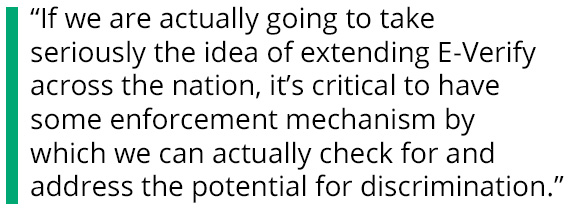 Griffith underscores that this dynamic has serious consequences for the affected workers. “Those people are going to be scrutinized more,” she says, “and one of the most salient things, I think, is that these are basically input errors. But they’re so common for particular groups that when you aggregate all of it across the country, it’s going to be felt by some in an inequitable way. Ultimately, if they really do have work authorization, they’ll be able to sort it out, but they might be out of work for a while. They might need a lawyer. They’re going through a lot more than others because of this dynamic.”
Griffith underscores that this dynamic has serious consequences for the affected workers. “Those people are going to be scrutinized more,” she says, “and one of the most salient things, I think, is that these are basically input errors. But they’re so common for particular groups that when you aggregate all of it across the country, it’s going to be felt by some in an inequitable way. Ultimately, if they really do have work authorization, they’ll be able to sort it out, but they might be out of work for a while. They might need a lawyer. They’re going through a lot more than others because of this dynamic.”
***
Many of the experts we spoke to say the best way to reduce illegal immigration while still meeting employer demands would be to create a more robust program for worker visas.
“I think it was a wrong turn once we decided to try to enforce immigration laws through employment,” says Geoffrey Heeren. “I think that those are two arenas that should be kept separate. The way to fix that would be to either have enough visas available to match the economic needs in the broader economy, or to really drive up wages with an enforcement system, which is really hard to achieve. But I’m fundamentally skeptical that you can use workplace enforcement as a mechanism of immigration enforcement because employers will always have different interests than the immigration enforcement bureaucracy. ICE’s interest is in enforcing immigration law. Employer’s interest is in making a profit. Even if the bigger, more reputable companies don’t use immigration status, or the lack of status, to exploit workers, they’re going to farm out many aspects of their operation to subcontractors. That’s just the way capitalism works.”
Over more than two decades, E-Verify has shown that it does not reduce illegal immigration, and comes at a significant cost to the taxpayer and to workers who are subjected to its uneven application and scant oversight. It is one of many major insertions of the government in the private relationship between employer and worker, a building block of capitalism; such insertions often turn out to be essential to a modern nation, but all are subject to ongoing political cost-benefit analysis. The benefits of E-Verify have proven elusive, while the dollar cost is evident, and some negative socioeconomic impact may be even more consequential. E-Verify may also have fostered an immigrant subculture of false documentation and fragmented identities pushing individuals further into the shadows, while incentivizing a sometimes duplicitous shift in large sectors of the economy — such as construction — away from employment toward independent contracting.
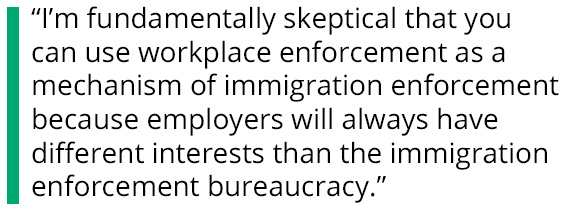 Perhaps the largest negative impact of E-Verify is hard to perceive. The existence of E-Verify creates an impression that the government has created an employment-centered gate that can impede undocumented immigration, but, as detailed above, the E-Verify gate is too easy to go around and a technological transformation that would accomplish the program’s aims carries a survellience-state stigma that puts it politically off the table. Given this reality, E-Verify may simply be a fig leaf. It may be a well-recognized part of our immigration management system, but it may not be able to do its assigned gatekeeping role.
Perhaps the largest negative impact of E-Verify is hard to perceive. The existence of E-Verify creates an impression that the government has created an employment-centered gate that can impede undocumented immigration, but, as detailed above, the E-Verify gate is too easy to go around and a technological transformation that would accomplish the program’s aims carries a survellience-state stigma that puts it politically off the table. Given this reality, E-Verify may simply be a fig leaf. It may be a well-recognized part of our immigration management system, but it may not be able to do its assigned gatekeeping role.
The enormous number of undocumented immigrants in our country working outside the legal system forcefully suggests that we are fooling ourselves if we think we have an adequate workplace enforcement system. Indeed, we may be fooling ourselves in a deep way by avoiding discussion of the reality that we need these workers; we are instead letting employers get the workers they need while easily avoiding penalties.
If effective reform of our immigration system is going to be realized, Congress should move away from the idea of reducing immigration through employer sanctions and consider options such as an expansive worker visa program that makes room for the immigrant workers required by U.S. employers and our economy writ large. Over the long term, our capitalist system needs our policymakers to be realistic.
Read More:
